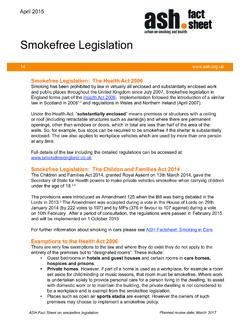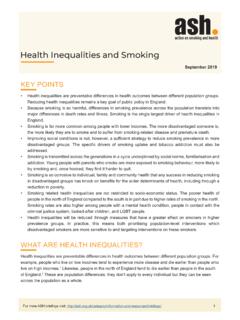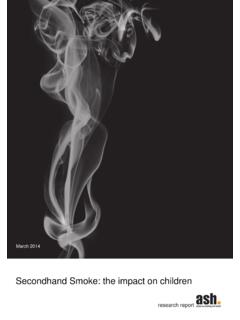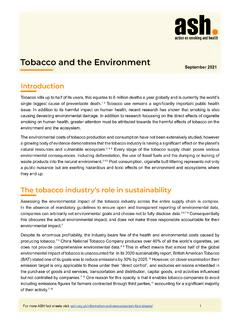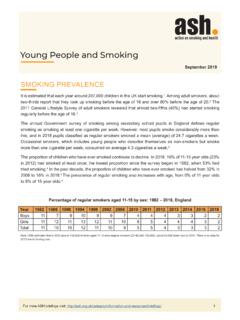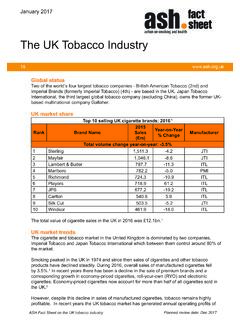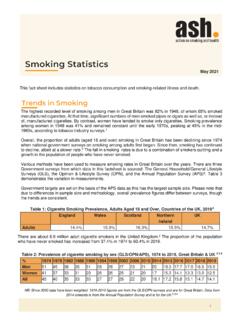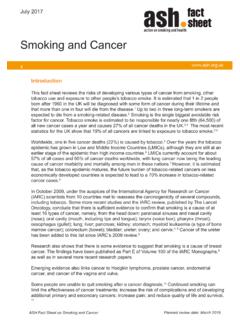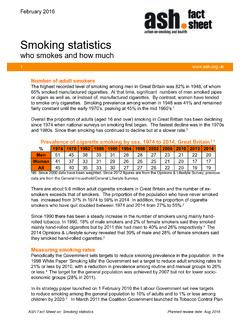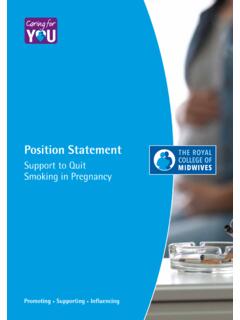Transcription of Smoking: Low income households - Landing Page
1 smoking : Low income householdsSmoking rates are much higher among low income addiction, and the loss of income it causes, can exacerbate and lock people addiction further locks children from low income backgrounds into a cycle ofinequality, by increasing their likelihood of smoking in later tobacco addiction is one of the most effective ways of eliminating healthinequalities. smoking is the single biggest cause of premature death in the UK and is responsible for at least half the difference in life expectancy between the richest and poorest in society (Marmot, 2010).Whilst smoking rates across all socio-economic groups have declined over the years, large inequalities remain and have widened significantly since 2012 (ONS, 2019).Inequality in smoking rates maintains the disproportionate burden of death and disease placed on people from low socio-economic groups and perpetuates health smoking rates are also linked to indicators of disadvantage including unemployment, loweducational attainment and mental health conditions, further compounding wider rates of smoking perpetuate inequality for low income groupsSmoking and PovertySmokers from the C2DE social group are more likely to bemore heavily addicted and to smoke more.
2 On average,C2DE smokers consume more cigarettes per day and aremore likely to have their first cigarette within 30 minutesof waking than those from higher socioeconomic groups(ASH/YouGov, smokefree GB Survey 2019).Tobacco addictions are financially burdensome andheavier addictions exacerbate this. ASH research showsthat, in the UK, nearly million households which includesomeone who smokes are currently in poverty, when thecosts of tobacco addiction are accounted for. However,around 428,000 people could be lifted out of poverty ifthe cost of addiction was returned to the household ,including around 235,0000 children (ASH, 2019). smoking and Poverty30%25%20%15%10%5% 0%Managerial rates by socio-economic classification in the UK 2018 (ONS, 2019)600,000500,000400,000300,000200,000 100,0000 households *Poverty defined as below 60% of equivalised Before Housing Costs (BHC) median incomeAdults below pension ageChildren Pension age adults428,000547,000235,000173,000 Number of households and people lifted out of poverty through returned tobacco expenditure (ASH, 2019)People from low socio-economic groups are also more likely to be exposed to secondhand smoke inthe home.
3 In response to the question: Does anyone smoke in your home most days? 20% ofpeople in the social grade E group responded positively compared to 8% in the social grade ABgroup. This further exacerbates health inequalities by increasing the likelihood of experiencingsmoking-related death and disease and compounding norms around smoking , making breakingaway from tobacco addiction even more smokeSmoking in the homeChildren with a parent who smokes are more likely to go on to smoke (NHS, 2017). It is estimated that each year at least 23,000 young people in england and Wales start smoking by the age of 15 as a result of exposure to smoking in the home (RCP, 2010). Higher rates of exposure to smoking in childhood maintains disproportionately high rates of smoking and tobacco addiction among low socio-economic groups (by leading to long-term tobacco addiction) thereby perpetuating addiction generally forms in childhood and, once formed, it is difficult to break away majority of people who smoke want to stop (ONS, 2019) and, on average, all people who smoke make similar numbers of quit attempts each year however, wealthier smokers are more likely to from low socio-economic groups face greater barriers to quitting smoking , experiencing higher levels of addiction, increased stress related to material hardship and higher rates of smoking amongst friends and family (Hiscock R et al, 2015).
4 Low income smokers face greater barriers to quittingLocal authority action to reduce smoking among low income groups Target stop smoking support. Local stop smoking services can reduce smoking inequalities by targeting groups with higher rates of smoking (Cancer Research UK, 2018). This can include innovative approaches to reaching people who smoke such as via housing associations and debt advice services (ASH, 2018).Tackle illegal tobacco. Cheap illegal tobacco fuels teen smoking , worsens health inequalities and is linked to wider organised crime. Local authorities should work collaboratively across regions with each other, police and HMRC to reduce the demand and national action. Some of the most effective measures to tackle smoking in disadvantaged communities happen at a national level, such as ensuring adequate funding is available for mass media campaigns and increasing taxes on tobacco products (APPG on smoking and Health, 2019).
5 0%Managerial and ProfessionalPercentage of cigarette smokers who quit by socio-economic classification (ONS, 2016)Routine 0%AB8%C1 C2 DE11%15%17%20%Regular smoking in the home by socio-economicclassification (ASH/YouGov, smokefree GB Survey 2019)
